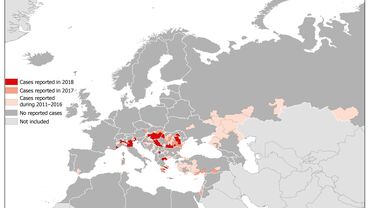Rapid risk assessment: Early large increase in West Nile virus infections reported in the EU/EEA and EU neighbouring countries
The early occurrence of a large number of human West Nile virus (WNV) infections in EU/EEA Member States and EU neighbouring countries suggests a high level of virus circulation in affected countries, which could potentially result in a high number of cases during the coming months.
Executive Summary
The majority of areas affected in 2018 were those from which cases were also reported between 2014 and 2017. It is likely that the virus will spread to more areas in the coming months, including areas where no human autochthonous cases have been reported in previous years, hence affecting a population that is potentially immunologically naïve. A WNV affected area is defined as an area at the third level of the Nomenclature of Territorial Units for Statistics (NUTS 3) where at least one human case of autochthonous WNV transmission has been confirmed
Public health professionals and clinicians in affected areas and also in as yet unaffected areas with suitable environmental conditions should be aware of the ongoing situation in Europe and the need to ensure the early detection and reporting of cases, which is crucial for monitoring the situation and timely implementation of response measures. It is also important to maintain collaboration between local, regional and national public health and veterinary authorities to obtain a comprehensive understanding of the epidemiological situation of WNV, assess the transmission risk to humans and consequently to implement timely response measures. It is important that clinicians are reminded to include West Nile fever (WNF) in the differential diagnosis of persons who have returned from affected areas with symptoms compatible with the disease.
Personal protection from mosquito bites is advisable for any person residing in or visiting affected areas, especially the elderly and immunocompromised who are at higher risk of developing West Nile neuroinvasive disease (WNND). Personal protective measures to reduce the risk of mosquito bites include the use of mosquito repellent in accordance with instructions indicated on the product label and wearing long-sleeved shirts and long trousers. In addition, window and door screens can keep mosquitoes out.
To prevent transfusion-transmitted WNV infection, EU/EEA countries should implement 28-day blood donor deferral or individual donation nucleic acid testing (ID-NAT) of prospective donors who have visited, or live in, an affected area. In affected areas, blood establishments should follow recommendations provided in the EU preparedness plan for blood safety. Donors of organs, tissues and cells living in or returning from an affected area should be tested for WNV infection. Systematic collection of epidemiological information on WNV infection among donors and recipients of substances of human origin (SoHO) is an important tool for national authorities to better assess the risk of transmission and the impact of preventive measures on the availability of SoHO.
Download








